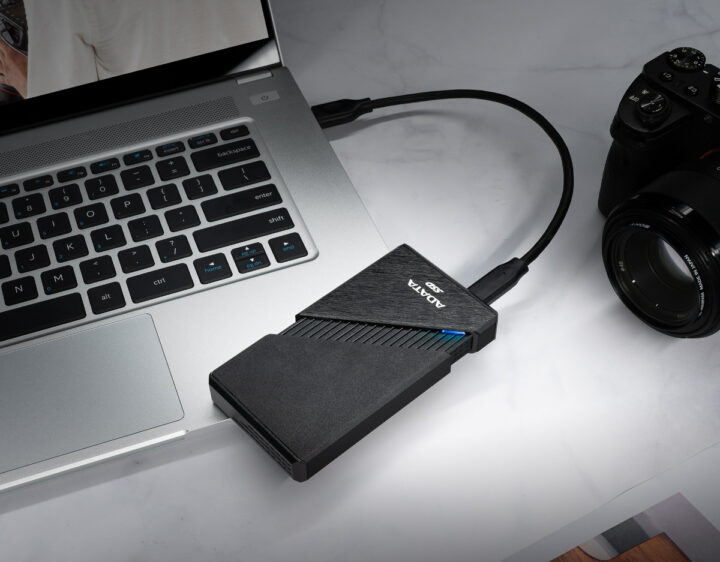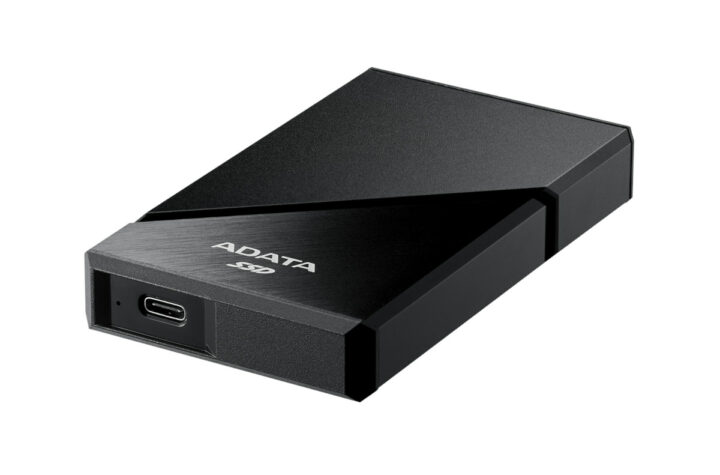ADATA SE920 is a small USB4 external SSD with 1TB or 2TB storage capacity that leverages the 40 Gbps connection enabled by USB4 and delivers up to 3,800 MB/s sequential read speed.
The storage device supports Thunderbolt 3 & 4 and is backward compatible with USB 3.2 and USB 2.0 standards. The USB-C port makes it suitable for mini PCs, laptops, SBCs, and even smartphones, but one potential downside of the small form factor is that it integrates a fan to cool the SSD although the user can enable/disable it by extending/retracting the telescopic case.
ADATA SE920 specifications:
- Capacity – 1TB / 2TB
- Host interface – USB4 up to 40Gbps, backward compatible with USB 3.2/2.0
- Performance
- Sequential Read – Up to 3,800 MB/s, or in other a 10GB file can be transferred in about 3 seconds
- Sequential Write – Up to 3,700 MB/s (USB4) or up to 3,200 MB/s (Thunderbolt 4)
- Power Supply – 5V/3A via USB
- Dimensions
- Fan-off (case closed) – 105 x 64.2 x 15.9mm
- Fan-on (case extended) – 122.56 x 64.2 x 15.9mm
- Weight – 81.52 grams
- Temperature Range – 5°C to 35°C
The device ships with a USB4 Type-C to C cable and a Quick Start Guide, and benefits from a 5-year limited warranty. The company says it’s compatible with Windows 10 / 11, MacOS 13 or later (formatting required for use), OS based on Linux Kernel 6 or later, and Android 13 or later. But it should work with any OS that supports USB4 or Thunderbolt 4. I always assumed USB4 and Thunderbolt 4 were pretty much identical from a user point-of-view, especially since the former relies on the Thunderbolt physical layer, but for some reason, the top write speed is higher with USB4 than with Thunderbolt 4 according to the specifications provided by ADATA.
The cooling solution is also interesting as the internal micro fan can be enabled and disabled simply by extending or pushing the case. ADATA says the fan can reduce temperatures by 10% to maintain stable data transmission. Most people will probably extend the case during operating, and retract it while carrying it around.
The company also claims the SE920 is the first USB4 external SSD, and while it may be technically true, Liliputing notes there are already a bunch of USB4 enclosures for sale – or coming soon – where the user simply needs to install its own M.2 NVMe SSD including the Acasis TBU405, the HyperDrive Next (but out of stock right now), and ORICO is currently running a Kickstarter campaign for their own USB4 SSD enclosure. I can also see a NewQ USB4 M.2 SSD enclosure going for $99 on Amazon. But note that you have to tread carefully when purchasing a USB4 NVMe SSD enclosure, as ORICO previously marketed a “USB4.0” SSD enclosure with Thunderbolt 3 and USB 3.2 chips, and I suppose others may have been doing the same thing.
The ADATA SE920 itself is said to be “one sale through global channels“, but I could not find it anywhere at the time of writing. Additional information may be found on the product page.

Jean-Luc started CNX Software in 2010 as a part-time endeavor, before quitting his job as a software engineering manager, and starting to write daily news, and reviews full time later in 2011.
Support CNX Software! Donate via cryptocurrencies, become a Patron on Patreon, or purchase goods on Amazon or Aliexpress






